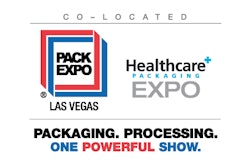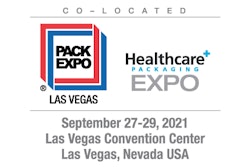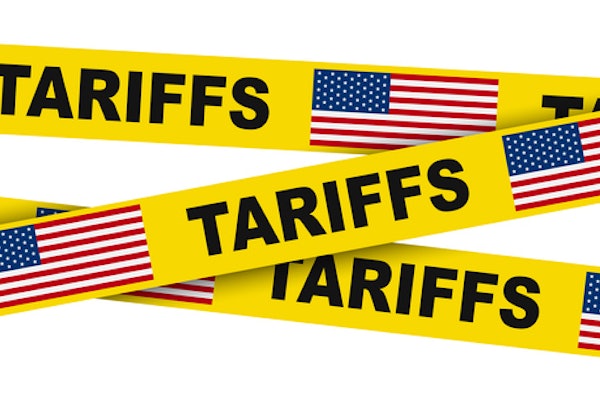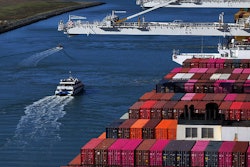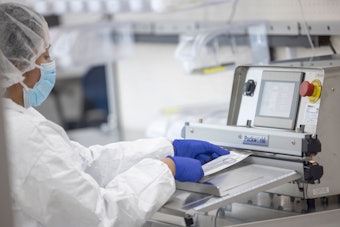UnPACKed with PMMI teams up with Packaging World to add an audio option to its top-shelf written content. On this episode of UnPACKed with Packaging World, Editor Emeritus Pat Reynolds reviews the latest technology trends and other items of note from his observations at PACK EXPO Connects.
With e-commerce exploding in 2020-2021, late-stage customization drives many packaging innovations, and companies need to remain flexible to keep up. Reynolds also comments on the increase in inspection equipment, noteworthy packaging materials and even some technologies entering the industry that even his experienced eye saw for the first time.
For more information on all noteworthy innovations from PACK EXPO Connects visit the Best of Connects: PMG Editors' Favorite Innovations.
To subscribe, rate, review and find more unPACKED podcast episodes, visit pmmi.org/podcast or find us on Apple podcasts, Spotify or iHeart Radio.
 | Read the full transcript below |
Sean Riley:
Buckle up folks, because today we have a Hall of Famer on the pod. Packaging World editor Emeritus, Pat Reynolds has been covering the packaging industry since long before podcasts existed. Along the way he has covered trade shows around the globe, including dozens and dozens of PACK EXPO events. Pat is going to revisit some of the technology and innovation he uncovered at PACK EXPO Connects. An old scribe like Pat can weed through what companies and exhibitors promote as new and what is actually innovative and worth exploring. Consider it an appetizer for our upcoming and in-person PACK EXPO Las Vegas and Healthcare Packaging EXPO in September to the Las Vegas Convention Center. Attendee registration opens in May for the world's most comprehensive packaging and processing show of 2021. Welcome to the podcast, Pat.
Pat Reynolds:
Hey, it's good to be with you, Sean. I've been admiring your UnPACKed podcasts from afar as it were, so it's good to get in on one at last.
Riley:
I'm almost positive you're our first Hall of Famer, our first packaging Hall of Famer that we've had on here. So this is a big, big day for us.
Reynolds:
Privileged for sure.
Riley:
You’ve obviously been at this for a long time, covering the packaging industry as a journalist. Long enough to have attended a ton of trade shows and learn the difference between what exhibitors say is new and what is really a new technology or innovation. So let's kind of talk about some of the things that you came across at last November's PACK EXPO Connects. I know one thing we discussed offline was late stage customization. For our listeners, for packaging, it generally refers to kind of being able to customize packaging as late as possible in the supply chain. And it got put on a palletizer and sent out the door because there's so many CKUs different and so many places on the omni-channel that it has to go out to. Customization is important. So long question short, what technologies did you find at PACK EXPO Connects to kind of address customization, late stage customization?
Reynolds:
Yeah, I'd have to say two things jumped out at me and both are driven by digital printing technology, which really only makes sense if you think about it since digital requires virtually no setup or plates. So why wouldn't that lend itself to customizing packaging at the latest possible stage in the supply chain? And the first of these late stage customization solutions is from Atlantic Zeiser, which is part of the Coesia group. They call it the DIGILINE Versa and it uses digital inkjet print heads from Rico plus UV curable inks that are suitable for printing on flat substrates, like paperboard, plastic film, or even metal. So if you think about it, what if different languages are required? Or suppose a brand owner wants QR codes on certain cartons, but not on others. Or if certain demographic groups require varied graphics on cartons containing the same products.
All you have to do is divert cartons right on the packaging line to the DIGILINE Versa system as they leave the cartoner. It's a great way for brand owners to segment and differentiate their packaging to serve market micro niches. The other technology that I saw at PACK EXPO Connects came from and it's called the package personalization system. Now, once again, it's digital inkjet print heads this time from Kyocera, and this is a sheet fed system. It's suitable for four colors, CMYK printing on paperboard or corrugated. Just think about the reduction in preprinted cartons brand owners would need to carry in inventory if they can print multiple versions of those cartons with little or no make ready time.
Riley:
That makes perfect sense. Things are changing so much and there's so many different places these have to go, that they need to have this digital printing component because it's print ready. You can do it as necessary. This is kind of in your wheelhouse. You've been really sort of knee deep in digital printing the last couple of years at Packaging World. And this also segues in nicely at PACK EXPO Las Vegas, which is looking great for an in-person event. In September, we have the PACKage Printing Pavilion, which touches very heavily on these advancements in digital printing, which would also tie into late stage customization. So what about things like inspection technology, any things like that that were featured at PACK EXPO Connects that were outside of the ordinary or things that stood out to you?
Reynolds:
One thing Sean, that really struck me as much as anything else is how many of the exhibitors offer one kind inspection technology or another. There's a lot of players, but the two of them stood out, both leveraged something that I had not heard much about before. And that is called hyperspectral technology.
Now I'm not going to dive into it too deeply, partly because it would take too long, but more importantly, because I don't think I'm able to. But what really matters is that because it collects and processes information from across the electromagnetic spectrum, it's able to identify foreign materials or contamination in the sealing area of rigid packages, more effectively than standard vision systems.
Now, both Engilico and Key Technology introduced their hyperspectral detection technology at PACK EXPO Connects. Engilico's offering called HyperScope is said to be the only imaging technology that can detect contamination through printed film. And Key Technology, which is part of the Duravant family of operating companies, introduced what they call the VERYX BioPrint digital sorter. It's described as the only sorting machinery that combines near infrared or NIR hyperspectral detection with color cameras. Because it analyzes a richer set of data about the materials it's sorting, it offers improved detection performance, and maximizes process yield. I'd expect to see it used in the food industry for well, things like removing shells or foreign material or various defective products.
Riley:
That is obviously huge because we all know what one product recall can do to a brand. We can identify brands in the past where things like that have happened. And even if they've rebounded from it, it's always tied to the brand. So it's become more and more important to make sure things like food in particular are, as inspected as much as possible. I seem to recall from us talking that you were also mentioning some things about variety packaging, which is also huge. Especially, in the big box stores where as you were saying, a tray or a corrugated case, instead of just holding the 24 primary packages of say, it's Gatorade, for example, all having the same flavor, instead it has 24 different flavors or a variety of flavors. What machinery was that? And could you expand on that a little bit?
Reynolds:
Yeah. Sometimes referred to as the rainbow packet. It's been a bit of a Holy grail when it comes to machinery builders and buyers, because the idea of automating such a thing is terribly attractive. Currently, I think a lot of it is done at fulfillment centers where corrugated cases need to be broken down and repacked and it's wasteful and expensive. So the one thing that I did come across that addresses it rather neatly is from Aagard. And the machine they showed at PACK EXPO Connects is called Myrias because it can deliver a myriad of configurations. Really a remarkable innovation I would have to say. The flavor varieties can range from one to six, case counts can be from 12 to 96. And on top of all that, it operates at 100 cases a minute.
Now, the other cool thing about this machinery is that it takes advantage of the linear servo motor technology that has been quietly, or actually not so quietly transforming the packaging machinery space over the past five years or so. In this particular application, the modular, scalable linear servo motor system that allows for independent control of multiple movers is Rockwell Automations iTRAK technology. But it's worth noting that BNR, Beckhoff, Siemens, and now I think I understand that even Schneider Electric has some version of this super versatile track technology. And Aagard's Myrias incorporates not one, but two of these iTRAK systems.
One is used to build the layers of single serve food cups, which eventually need to make their way into the corrugated cases. And the other iTRAK is used to transport wraparound corrugated cases from the station where they're erected to the station where they have cups inserted into them. Now don't even get me started on the upstream operations on this myriad system, because it involves six gantry robots to pick cups from the large infeed trays they're stacked on and placed them into six flavor lanes leading to the downstream case packing operations. It was really something to see.
Riley:
What I was picturing in my head when I was posing the question you started answering, it was probably a lifetime ago. I was in a contract packaging facility. And they were literally like you explained, taking some kind of sports drink out of boxes by flavor, and then mixing them by hand. There was people at the end of the line doing this by hand, which is obviously very labor intensive and not something that you would want to do on a large scale basis, but they were having to do this at this contract packager. It sounds like from what you're saying, they have gotten to the place where we can use robots to replace that, automate it and make it a much easier and faster process.
Reynolds:
Yep, that's about right.
Riley:
Yeah. So we know machines are always at the center when it comes to PACK EXPOs, whether it's a live show or the virtual PACK EXPO Connects. We also always have materials which are in the new, whether it's for sustainability, or for efficiency, or things moving into different packages. So what did you see from an innovation standpoint in terms of materials at PACK EXPO Connects?
Reynolds:
Well, the short answer would be an awful lot, but I'd have to say that one area really heating up in the most interesting way is mono-materials. Now, the idea here of course, is to move away from multi-material packaging constructions, because they complicate recycling. Picture for instance, a standup pouch. It might include nylon for strength, aluminum foil for oxygen barrier, polyester as a surface layer that can carry reverse printing, and then a variety of polyethylene or linear low density, PE layers for heat seal and or easy peel characteristics. Now, once all these layers are adhesive or extrusion laminated together, they just do not fit readily into existing recycle streams. And separating them is no good option. It's just too costly and too time consuming.
Riley:
That's interesting. And your colleague, Matt Reynolds has touched on this a bunch and really opened my eyes that there just isn't options for these recycle streams Now that these mono-materials are available to try to fix that solution, who are some of the people that are operating in this space?
Reynolds:
Well, there are quite a few, but among the ones that I saw at PACK EXPO connects are Amcor flexibles, Toppan, Clysar, and then a joint development involving santis, Wipf and Optima. So why don't we start with Amcor which used its PACK EXPO connects showroom to introduce what it calls its AmPrima portfolio.
Now, a number of options are available in this family of films and all are compatible with the PE recycled stream. A number of technologies, some of them proprietary are behind this development. Worth noting though, is that on the materials side, contributions came from such things as compatible technologies, barrier coatings and additives, and blends of high performance polymers. These compatible technologies are especially interesting. I think Dow was among the leaders in coming out with these. They do some remarkable things in terms of letting you mix certain polymers and have them go through a recycle stream much more readily than they otherwise would have.
Now moving on to Toppan. Their announcement at PACK EXPO Connects was in regard to their GL barrier films. Launched in January, were full-scale sales of PE based and by actually oriented polypropylene based model material packaging that joined the PET based options that Toppan had already commercialized. The PE and BOPP based varieties were made possible by taking advantage of the technologies that Toppan has developed for over more than 40 years as a leader in the manufacturer of transparent vapor deposited films. Toppan anticipate sales of these new films should reach $20 million in 2025. And the firm says, they'll continue further development in this mono metal material sector. Elsewhere, in the polypropylene space, we learned of an interesting joint development by santis, Wipf, and Optima. They call it their GreenLution project. And it's aimed at coming up with a fully recyclable coffee capsule, featuring a polypropylene based single material.
Now santis does the co-extrusion of the seven layer structure and the subsequent thermoforming. A key component in the structure is a new grade of EVOH from an unnamed supplier. Because this grade of EVOH has improved barrier characteristics, less of it is needed in the cast co-extrusion. Consequently, the sheet going into the thermoforming system is about 98% polypropylene. Now Wipfs contribution to the GreenLution project is the lidding material that gets heat sealed to these coffee capsules. And this lidding material is described rather vaguely at this point anyway, as a recyclable film.
And as for Optima, they make the CFL machine on which the capsules are filled and sealed. Oh, and one last observation on this GreenLution's project, the thermoformed capsule material contains an NIR detectable component that makes the polypropylene capsules more readily detectable in the sortation process at the municipal recycling facility or MRF as they're commonly called. And finally, Clysar announced it has introduced a mono material shrink film that was approved for the store drop off label that is part of the, How2Recycle program launched way back in 2008 by the Sustainable Packaging Coalition. That How2Recycle program is now under the auspices of GreenBlue. This Clysar material is called EVO recyclable shrink film, and it was developed in collaboration with the Sustainable Packaging Coalition. And it has been verified by third party testing to meet the requirements of the Association of Plastics Recyclers.
Riley:
Sustainability is huge. Everybody wants to be as sustainable as possible and that is quite a variety of options that people can try to streamline that whole recycling component. We really touched on a good variety of kind of high level things. I know you always put together a pretty thorough innovations report after the shows. Did you want to put in a cheap plug for that?
Reynolds:
Oh, sure. Why not. Cheap plugs are always good. That would be the January issue, of course. And you're right. We do that each year. A whole crew of PMG editors scoured the aisles virtually and everybody contributed a great deal of information in four or five key categories, machines, materials, controls, et cetera. So anyone listening who wants more detail, please go there.
Riley:
Yeah. And that's a great way, even if you've attended the show in person in the past or for this one virtually, it gives you a refresher and as well as it's almost impossible, it is impossible to cover everything as an attendee. Or if you're an exhibitor just to see what your competition is doing, that's it. Those reports are always a great way to show everybody things they might've missed or kind of refresh them on some things that they passed up on. So that is a good thing to remind people of.
Reynolds:
Yeah. True enough. And boy, speaking of shows, I am really looking forward to PACK EXPO, Las Vegas.
Riley:
Things are looking good and I'm looking forward to seeing you and everybody else again in person. I would just like to thank you for taking some time to come on here and talk with us.


